

The California gold rush ended in 1855 when most of the easily accessible placer gold had been removed, but that didn´t mean that there was no gold left at this point. Backgroundĭuring the early days of the California gold rush, there was quite a lot of placer gold around that could be accessed comparatively easy and didn´t require much of an investment in equipment to be extracted in a profitable manner.

Gold is heavy and will settle at the bottom together with other heavy materials, while lighter materials such as dirt and light sand will wash away. The sluice box works the normal way that we are familiar with from many different types of gold extraction operations. At the same time, small objects – including gold – are allowed to escape through small holes in the cylinder and are dumped into a sluice box. The trommel is sloped downward toward a rubber belt (”the stacker”), which transports oversized materials such rocks and dump them behind the dredge. Sediments are picked up by these buckets, and dumped into a steel rotating cylinder – a kind of trommel commonly referred to simply as ”the screen”. The large type of gold dredge typically feature steel buckets fastened on a circular, continuous ”bucketline”. Today, considerably smaller gold dredges are sold to individuals interested in seeking gold. They are less labour intensive than panning.ĭuring the first half of the 20th century, large multi-story gold dredges were built. A gold dredge retrieves sediment (such as and, gravel or dirt) from a gold placer deposit, e.g.


 0 kommentar(er)
0 kommentar(er)
